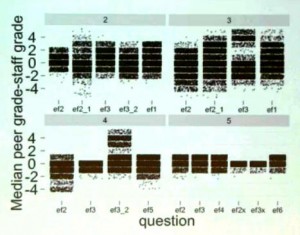Coursera as Innovation Accelerator?
by Derek Bruff, CFT Director
If you watch the talk given by Stanford professor and Coursera co-founder Daphne Koller here at Vanderbilt a couple of weeks ago, it’s easy to miss what might be the most transformative aspect of Coursera’s foray into massive open online courses (MOOCs).
Before I point out that aspect, a little set-up: At one point in her talk, which you can view at the bottom of this post, Koller describes the peer grading tools that were added to the Coursera platform this summer. The first course to use peer grading was a course on human-computer interaction (HCI) taught by Stanford professor Scott Klemmer. Can students evaluate each other’s work as well as an instructor can evaluate that same work? Koller addressed this very natural question by sharing data from the HCI course:
 This visualization shows the spread of student scores for various assignments, centered on the instructor score for those assignments. For the earlier assignments in the course, student grades were all over the place, but for later assignments, student grades clustered tightly around instructor grades, indicating that students became more accurate evaluators of their peers’ work over time.
This visualization shows the spread of student scores for various assignments, centered on the instructor score for those assignments. For the earlier assignments in the course, student grades were all over the place, but for later assignments, student grades clustered tightly around instructor grades, indicating that students became more accurate evaluators of their peers’ work over time.
Koller identifies a few possible causes for this increased accuracy. It might be that students get better at grading their peers’ work over time. It could be that only the better student graders persist in the course. (Coursera is somewhat famous for its high drop-out rates.) Koller, however, points to one reason above others: “We learned how to construct better grading rubrics.”
Koller didn’t say how the HCI rubrics changed over time. My guess is that they became more specific and objective, given what I know of the literature on assessment. However, I want to focus on the rest of Koller’s statement:
“We learned how to construct better grading rubrics. And that’s experience we can now use in designing grading rubrics for subsequent classes.”
Earlier in the day, during another meeting with Koller I attended, she shared a few more details about Coursera’s roll out of peer grading. After the first couple of weeks of using peer grading in the HCI course, two more Coursera courses began using peer grading, and these courses used the “better rubrics” that had been developed in the HCI course. These were courses in different disciplines at different institutions that were more effective because of lessons learned just a couple of weeks earlier in the HCI course.
How long does it usually take a pedagogical innovation to make the jump from one discipline to another? I would say 8-10 years at a minimum. Coursera did it in two weeks.
 Okay, so perhaps this example is a pretty minor innovation. And it may not be all that innovative anyway, just more consistent with what we know about effective rubric creation. But I was struck by the idea of Coursera serving as a vector for pedagogical innovation between disciplines and universities. There are now 33 colleges and universities providing online educational experiences through Coursera, each with at least a handful of faculty interested in experimenting in online learning and pushing the boundaries of this MOOC format. There’s potential there for valuable innovation, potential that will be enhanced by the role Coursera plays in helping these faculty learn from each other.
Okay, so perhaps this example is a pretty minor innovation. And it may not be all that innovative anyway, just more consistent with what we know about effective rubric creation. But I was struck by the idea of Coursera serving as a vector for pedagogical innovation between disciplines and universities. There are now 33 colleges and universities providing online educational experiences through Coursera, each with at least a handful of faculty interested in experimenting in online learning and pushing the boundaries of this MOOC format. There’s potential there for valuable innovation, potential that will be enhanced by the role Coursera plays in helping these faculty learn from each other.
Sometime soon, Coursera will launch a “course” for the faculty teaching on the Coursera platform and those like me who support them, intended to help good ideas spread through the Coursera network. There’s talk of a Coursera conference next year, as well. And next week, I’m heading to the annual conference of the POD Network where I’ll meet with teaching center staff from several Coursera institutions to swap ideas and strategies.
There are many questions to explore concerning teaching and learning in these massive open online courses, including serious questions about the limits of this platform for fostering student learning. I’m excited about the potential for collaboration with faculty and staff around the world interested in tackling these questions, a potential that Coursera seems eager to help realize.
Image: “Moving out of the blue,” zen Sutherland, Flickr (CC)

Leave a Response